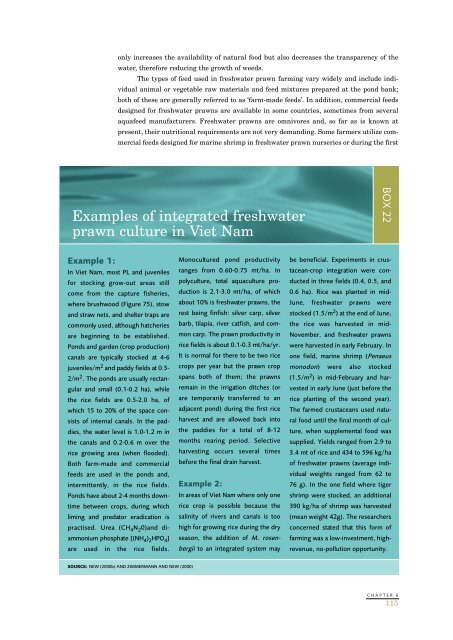Create successful ePaper yourself
Turn your PDF publications into a flip-book with our unique Google optimized e-Paper software.
only increases the availability of natural food but also decreases the transparency of thewater, therefore reducing the growth of weeds.The types of feed used in <strong>freshwater</strong> prawn farming vary widely and include individualanimal or vegetable raw materials and feed mixtures prepared at the pond bank;both of these are generally referred to as ‘farm-made feeds’. In addition, commercial feedsdesigned for <strong>freshwater</strong> <strong>prawns</strong> are available in some countries, sometimes from severalaquafeed manufacturers. Freshwater <strong>prawns</strong> are omnivores and, so far as is known atpresent, their nutritional requirements are not very demanding. Some farmers utilize commercialfeeds designed for marine shrimp in <strong>freshwater</strong> prawn nurseries or during the firstExamples of integrated <strong>freshwater</strong>prawn culture in Viet NamBOX 22Example 1:In Viet Nam, most PL and juvenilesfor stocking grow-out areas stillcome from the capture fisheries,where brushwood (Figure 75), stowand straw nets, and shelter traps arecommonly used, although hatcheriesare beginning to be established.Ponds and garden (crop production)canals are typically stocked at 4-6juveniles/m 2 and paddy fields at 0.5-2/m 2 . The ponds are usually rectangularand small (0.1-0.2 ha), whilethe rice fields are 0.5-2.0 ha, ofwhich 15 to 20% of the space consistsof internal canals. In the paddies,the water level is 1.0-1.2 m inthe canals and 0.2-0.6 m over therice growing area (when flooded).Both farm-made and commercialfeeds are used in the ponds and,intermittently, in the rice fields.Ponds have about 2-4 months downtimebetween crops, during whichliming and predator eradication ispractised. Urea (CH 4 N 2 0)and diammoniumphosphate [(NH 4 ) 2 HPO 4 ]are used in the rice fields.Monocultured pond productivityranges from 0.60-0.75 mt/ha. Inpolyculture, total aquaculture productionis 2.1-3.0 mt/ha, of whichabout 10% is <strong>freshwater</strong> <strong>prawns</strong>, therest being finfish: silver carp, silverbarb, tilapia, river catfish, and commoncarp. The prawn productivity inrice fields is about 0.1-0.3 mt/ha/yr.It is normal for there to be two ricecrops per year but the prawn cropspans both of them; the <strong>prawns</strong>remain in the irrigation ditches (orare temporarily transferred to anadjacent pond) during the first riceharvest and are allowed back intothe paddies for a total of 8-12months rearing period. Selectiveharvesting occurs several timesbefore the final drain harvest.Example 2:In areas of Viet Nam where only onerice crop is possible because thesalinity of rivers and canals is toohigh for growing rice during the dryseason, the addition of M. rosenbergiito an integrated system maybe beneficial. Experiments in crustacean-cropintegration were conductedin three fields (0.4, 0.5, and0.6 ha). Rice was planted in mid-June, <strong>freshwater</strong> <strong>prawns</strong> werestocked (1.5/m 2 ) at the end of June,the rice was harvested in mid-November, and <strong>freshwater</strong> <strong>prawns</strong>were harvested in early February. Inone field, marine shrimp (Penaeusmonodon) were also stocked(1.5/m 2 ) in mid-February and harvestedin early June (just before therice planting of the second year).The farmed crustaceans used naturalfood until the final month of culture,when supplemental food wassupplied. Yields ranged from 2.9 to3.4 mt of rice and 434 to 596 kg/haof <strong>freshwater</strong> <strong>prawns</strong> (average individualweights ranged from 62 to76 g). In the one field where tigershrimp were stocked, an additional390 kg/ha of shrimp was harvested(mean weight 42g). The researchersconcerned stated that this form offarming was a low-investment, highrevenue,no-pollution opportunity.SOURCE: NEW (2000b) AND ZIMMERMANN AND NEW (2000)CHAPTER 6115
















